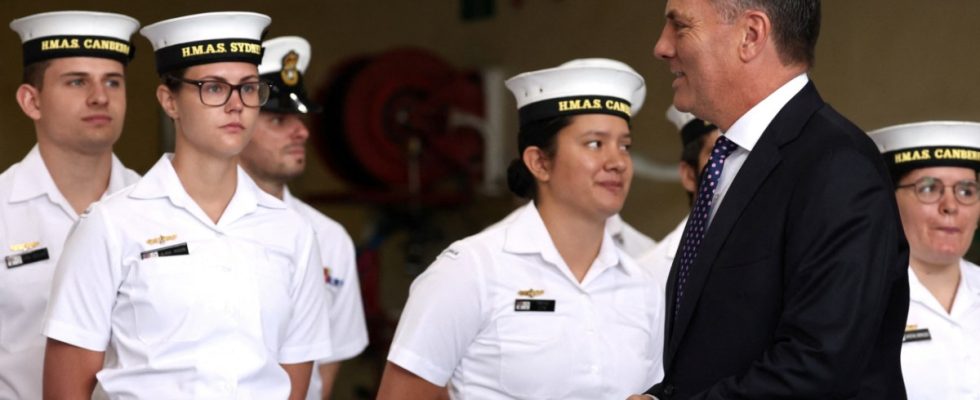The mood on Garden Island in Sydney Harbor Bay on Tuesday was reminiscent of the joyful anticipation of Christmas presents. The event at the naval base would be about the Royal Australian Navy’s new equipment – that was clear to everyone who came or watched the broadcast on live television. Why else would Defense Minister Richard Marles schedule this major media conference?
Marles greeted a group of Marines standing at attention, some of whom beamed at him with bright eyes. And when he stepped up to the microphone a little later with Defense Industry Minister Pat Conroy and Navy Chief Mark Hammond, he actually had rich gifts to announce for the fleet. Marles spoke of “a very historic day”. He announced that the Social Democratic Labor government of Prime Minister Anthony Albanese would invest the equivalent of around 6.7 billion euros in new warships over the next ten years. Instead of eleven as now, Australia will have 26 of them by the end of the 2040s at the latest, making it “the largest fleet since the Second World War”. Hammond praised a “real boost to understanding the important role Australian Marines play across the Indo-Pacific region”. He added that the new plan would build Australia’s “largest surface combat force in generations – and over time the deadliest.”
China is consistently expanding its influence in the region
The destructive power of a new fighting machine does not have to be carried forward as triumphantly as Vice Admiral Hammond did. On the other hand, times in the Indo-Pacific are actually not rosy. The large neighboring country China is consistently working to expand its influence in the region by tempting Pacific island states with quick money. In addition, the government in Beijing itself has said that, if necessary, it would use force to convince the democratically ruled island of Taiwan to belong to its authoritarian giant empire.
Substantial disputes over the region’s trade routes cannot be ruled out. Deterrence through a strong military is therefore necessary. Hammond recalled the “background of increasing geostrategic uncertainty.” Defense Minister Marles said: “Australia’s modern society and economy rely on access to the high seas, the trade routes for our imports and exports, and the submarine cables for the data that enable our connection to the international economy.” That is why the expansion of the fleet is necessary, which coincides with another of Australia’s ambitious military projects: Australia is working with the USA and Great Britain on building a fleet of nuclear submarines. As part of the 2021 AUKUS trilateral security partnership, Canberra may be able to deploy these as early as the 2030s.
Their number is expected to double: Australian warships are based at the Garden Island base in Sydney Harbor.
(Photo: Bianca De Marchi/dpa)
It was therefore logical that the Albanese government announced on Tuesday that it would upgrade its navy. She is considered to be more considerate and sensitive, not as brutal as her predecessors from the liberal-conservative coalition. The then Defense Minister and current opposition leader had this in April 2022 Peter Dutton said: “The only way to keep peace is to prepare for war.”
Orders could also go to Germany
We have not heard such harsh statements from Labor since the change of power in May 2022. However, it was also time for Albanese’s government to finally set a clear direction in security policy. In April 2023 it published the results of a comprehensive review of the Australian military. The finding was that the army was “not fully fit for purpose.” For a long time, the cabinet did not say what followed.
And now there is this plan that calls for an “Enhanced Lethality Surface Combatant Fleet,” loosely translated as a surface combat fleet that is more lethal to the enemy than the previous one. The upgraded fleet will include: three modernized Hobart-class destroyers, which is a type of destroyer in the Australian Navy. Six Hunter-class frigates, the youngest frigate type in the Australian Navy. Eleven new multi-role frigates that will gradually replace the six remaining Anzac-class frigates. Six new large surface ships that can be used like robot ships without a crew if necessary. The Hunter frigates are built at the Osborne shipyard in Adelaide, South Australia, and the large surface ships are built at the Henderson shipyard in Perth, Western Australia. The orders to build the additional ships could go to Germany, South Korea, Japan or Spain.
The government was unable to fulfill all wishes. Instead of nine Hunter-class frigates, there are only six. There was immediate criticism from the opposition. Andrew Hastie, the coalition’s defense policy spokesman, accused Marles of not being able to assert himself against his ministerial colleagues in the fight for a better defense budget. “He couldn’t secure more money,” Hastie said. However, his criticism did not sound particularly convincing. When the National Liberals governed, they did not make Australia’s fleet as strong as it should now be.

